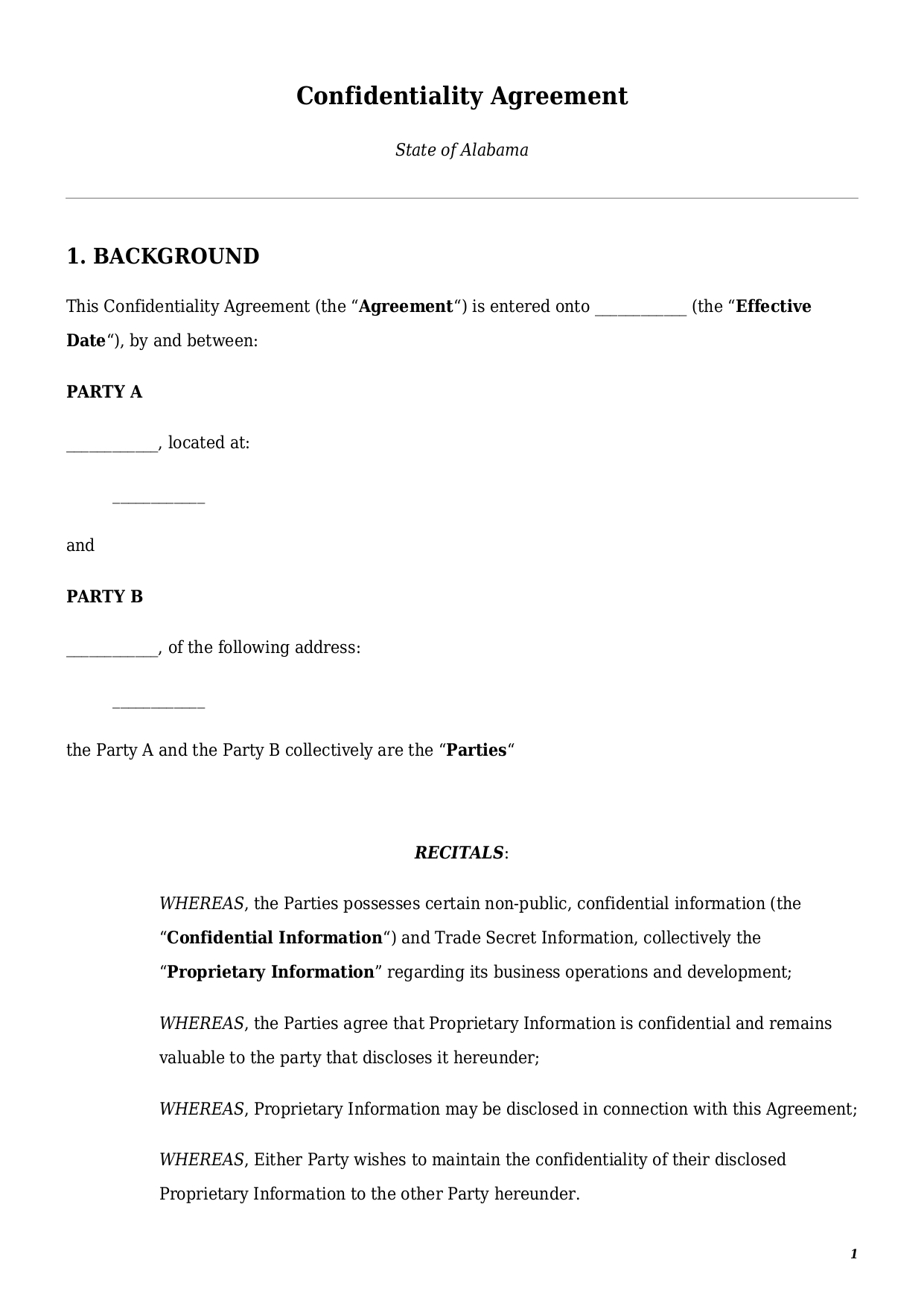Confidentiality Agreement
Reviews


What Is a Confidentiality Agreement?
A confidentiality agreement is a legal agreement that protects confidential information from its unauthorized sharing with third parties. A confidentiality agreement is widely known as a non-disclosure agreement, or simply NDA. The main purpose of a confidentiality agreement template is to protect information that is being shared between the parties in the course of employment relations, business transactions, and even daily life situations.
The key element for an NDA agreement template is that it covers confidential information. There is no defined list of what data can be treated as confidential information. It may include information about the production process, trade secrets and know-how, a list of customers or subcontractors, and much more.
The following information cannot be protected by a non-disclosure agreement template:
- information from open sources, also known as public knowledge (e.g., on the Internet, on social media, in newspapers);
- information to which the general public has access (e.g., information about activities of federal and state authorities);
- information that cannot be confidential by virtue of law (e.g., data on the ecological safety of water).
A confidentiality agreement template can be of two types:
- unilateral NDA (i.e., one-way exchange of information). This is when only one party shares their sensitive information with the other party. And the other party, in turn, accepts to keep such information secret. This is common for employment relations when a new employee joins a company and gets access to certain sensitive data.
- two-way exchange of information. Under this type of confidentiality agreement, both parties share their sensitive information with each other.
A non-disclosure confidentiality agreement has two parties:
- receiving party (that receives confidential information); and
- disclosing party (that shares such confidential information).
When Should You Use a Confidentiality Agreement?
Confidentiality agreements have become an integral part of any employment or business process. It might be particularly vital for the following situations below:
Hiring New Employees
For both small and big businesses, having new staff within the organization is always a challenge. If an employee has access to sensitive information about your business, think about an employee confidentiality agreement.
Hiring a Freelancer or Consultant
If you are looking to hire a freelancer or external consultant for your business, think about having a simple NDA agreement sample at hand. In the course of providing their services, freelancers may eventually have access to some sensitive information.
Product Development
Sharing designs, formulas, or other confidential information in the course of product development with external third parties can be risky. Thus, it is essential to use an NDA confidentiality agreement template.
Investment Pitches
You may have a bunch of great business ideas you want to share with potential investors to get some funds to start up. Signing an NDA with potential investors can protect your ideas against unsolicited disclosure to third parties.
Starting a Business
Whether you start a partnership, LLC, or joint venture, having a signed confidentiality agreement sample adds an additional layer of protection. A written agreement ensures that both shareholders or founders have a duty to keep certain business information secret for a certain period of time.
What is the difference between a non-compete agreement and a confidentiality agreement?
It is a common thing to confuse an NDA disclosure agreement template with a non-compete agreement template. While both documents are used together in many cases, they serve a different purpose.
A non-compete agreement is used in business or employment relations:
- to restrict former employees from competing against their ex-employers;
- to restrict ex-partners from setting up the same business;
- to limit solicitation of employees, contractors, or consultants; or
- to limit employment of ex-employees with competitors.
Contrary to that, a non-disclosure agreement sample is used:
- to protect sensitive information during and some time after the relationship ends between the parties; and
- to limit disclosure or misuse of confidential information, including trade secrets, know-how, intellectual property rights, etc.
Another distinctive feature between both documents is that a restricted party under a non-compete agreement has a right to compensation. For example, if under a non-compete agreement an employee cannot work for companies in the same industry for 1 year after termination of a contract, for that one year an employee is entitled to regular monthly compensation. However, this is not the case for confidentiality agreements for staff or key employees.
How to Write a Confidentiality Agreement?
Neither federal nor state laws define a sample NDA format. At the same time, without the elements listed below, an NDA agreement template cannot be legally binding:
Scope of Confidential Information
The text of the non-disclosure agreement sample should define which information is considered confidential. It helps the receiving party to perform their confidentiality obligations under the contract better.
Duties of Receiving Party
Parties should spell out the duties of a party with which confidential information is being shared. For example, if a receiving party is a company, it is worth limiting the list of employees who can get access to sensitive information in question.
Duration
Practically speaking, a confidentiality agreement cannot last indefinitely. Firstly, it is hard to enforce compliance with non-disclosure obligations all the time. Secondly, some sensitive information with time may become public knowledge. Therefore, parties have to define the moment till which the agreement shall remain in effect.
The average lifespan for a secrecy agreement template is 2-5 years. The exact duration depends on the industry, quality of sensitive information, and relations between the parties. For instance, a workplace confidentiality agreement template may last for 5 years, while a secrecy agreement for a startup can be valid for 6 months.
Permitted Disclosures
The nondisclosure form template should define the list of circumstances when the receiving party has a right to disclose. Those are normally cases where public authorities or third parties, by virtue of court order, wish to get access to the sensitive information.
Return or Destruction of Materials
Parties should consider step-by-step procedures once their relations come to an end. It usually requires the parties to destroy all hard or electronic copies of sensitive information they exchanged during the agreement’s duration.
Get Your Workplace Confidentiality Agreement Template
FasterDraft offers customized secrecy agreement templates for businesses and employers. In order to create your personalized confidentiality agreement template, follow the steps below:
- Click on the button “Create Document.”
- Fill in the questionnaire.
- Select a format for the nondisclosure form template—PDF or Word.
- Make a payment.
- Your customized template is ready for download.
Table of content
Frequently Asked Questions (FAQ)
-
1. What Is a Confidentiality Agreement Used For?
A confidentiality agreement, or NDA, is a legal agreement between the parties that is aimed at protecting sensitive information. Sensitive information can have different forms and types, including intellectual property like know-how or technologies, lists of suppliers or contractors, accounting information, and others.
-
2. Are Confidentiality Agreements Enforceable?
Yes, a confidentiality agreement becomes enforceable and legally binding for parties once it is duly signed and executed by both parties.
-
3. What Happens If You Break a Confidentiality Agreement?
Breaking a confidentiality agreement can have serious consequences. Most nondisclosure agreement templates contain penalties for the party that violates provisions of the agreement. Such penalties may include compensation for direct material damages as well as reputational damages.
-
4. How to sign a confidentiality agreement?
A confidentiality agreement can be signed using an e-signature or by hand. Neither format affects the enforceability or validity of a document. If a party to a confidentiality agreement is an individual, they should put their signature. If a party to the agreement is a legal entity, in that case a company’s representative shall sign such document. A representative should act by virtue of the company’s bylaws or based on a separately issued power of attorney.
-
5. What is the difference between an NDA and a confidentiality agreement?
There is no difference between those two documents, as they are simply different titles of the same document. A confidentiality agreement can be referred to as a non-disclosure agreement, NDA or secrecy agreement.
-
6. Is it ever okay to breach a confidentiality agreement?
The breach of any contract leads to legal consequences. Such legal consequences may include the application of penalties, compensation of damages, and payment of fines. The exact legal consequences differ depending on the type of confidentiality agreement.

Looking for something Different?
Start typing to find out our collection of legal documents and contract templates
